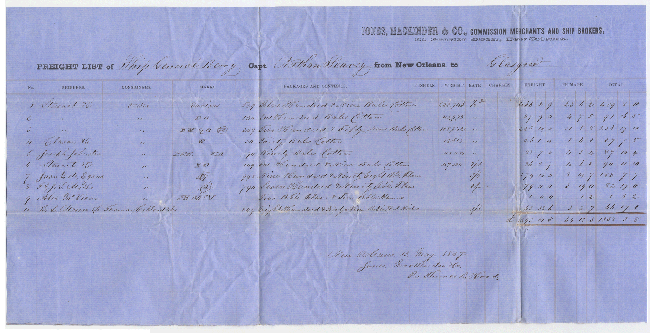Printed document of various sizes and formats. Like the manifest, the Freight List has printed columns for the names of shippers and consignees, packages, and their marks and contents. Unlike the manifest, however, a Freight List records the rate at which the transported cargo will be charged, the cost levied for freight and primage, and the final sum due from either the shipper or the consignee. It is a private business documents and was not certified or signed by any public official. “Freight List” usually appears in bold print, and the name of the agent executing the document is often present.
The terms “freight” and “cargo” are often misunderstood. Freight is the sum paid by a shipper who hires a vessel to transport his goods, and cargo, while Freight Lists provide a record of the charges assessed for the shipment of cargo. Three kinds of charges were assessed: general charges, freight, and primage. General charges were assessed for any unusual expenses that had been occurred in transporting the cargo. Freight was a charge generally levied on the principle that the merchant was paying for the use of the ship (or part of a ship) for a specific time. Although it was usually assessed by the weight or volume of his cargo, it was possible for shippers to owe freight money simply because they had reserved the use of part of the vessel, regardless of whether they had actually filled it. Primage, the third charge, was for the care of the goods during transport, typically assessed at 5 to 15 percent of the freight. Originally it was a gratuity for the cabin, but by the mid-nineteenth century it was paid to owners. These three charges were collected together, from either the shipper or consignee. The responsible party was designated in the Charter Party or the Bill of Lading. Consequently the Freight List was essentially a business document between the shipper, the consignee, and the vessel transporting the cargo.

This Freight List for an 1857 voyage from New Orleans to Glasgow lists the shippers and consignees and the charges assessed for the transportation of their goods. Printed on the form is the name of the agent whose business it was to bring cargoes and available vessels together.
